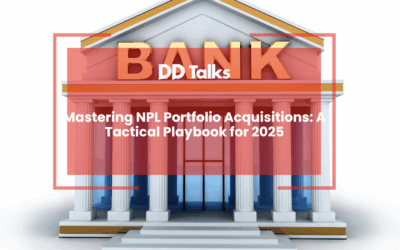Key Takeaways
- Non-performing loans (NPLs) in real estate offer significant investment opportunities, particularly in European markets like Italy, Greece, and Spain where higher concentrations persist.
- Successful NPL investing requires understanding both financial restructuring and property management across the asset lifecycle from loan default through disposition.
- Market dislocations create pricing gaps between distressed purchase prices and intrinsic property values, forming the fundamental investment thesis for NPL real estate.
- Effective valuation requires multi-dimensional analysis incorporating loan characteristics, property fundamentals, and jurisdiction-specific factors affecting recovery timelines.
- Risk management frameworks must address legal, market, and operational risks through diversification, thorough due diligence, and active asset management.
- Technology advancements in data analytics, digital asset management, blockchain, and virtual property inspection are transforming NPL portfolio management efficiency.
- NPL real estate funds typically offer 12-20% target IRRs through specialized closed-end structures with 5-7 year investment horizons, providing institutional investors access to professional management in this complex asset class.
Table of Contents
- Understanding NPL Real Estate: Fundamentals and Opportunities
- How Do Distressed Real Estate Markets Create NPL Investment Potential?
- Valuation Strategies for NPL Real Estate Assets
- Managing Risk in NPL Property Portfolios
- Implementing Effective NPL Real Estate Investment Strategies
- Technology Advancements Transforming NPL Asset Management
- Due Diligence Framework for NPL Real Estate Acquisitions
- NPL Real Estate Funds: Structure, Operations and Returns
Understanding NPL Real Estate: Fundamentals and Opportunities
Non-performing loans (NPLs) in real estate represent a significant opportunity for astute investors across Europe. These assets, typically defined as loans where borrowers have failed to make scheduled payments for 90 days or more, create a unique investment class within the property market. The European banking sector continues to hold substantial NPL portfolios, with countries like Italy, Greece, and Spain maintaining higher concentrations despite regulatory pressure to reduce these exposures.
NPL real estate portfolios encompass various property types, from residential mortgages to commercial real estate loans. When these loans default, they create opportunities for investors to acquire properties at discounted valuations through various mechanisms including direct loan purchases, foreclosure processes, or REO (Real Estate Owned) acquisitions. The fundamental appeal lies in the potential value gap between the distressed purchase price and the property’s intrinsic or future market value.
For investors, understanding the lifecycle of NPL real estate assets is crucial. This journey typically progresses from loan default through workout attempts, potential foreclosure proceedings, and ultimately disposition or redevelopment of the underlying property. Each stage presents distinct opportunities and challenges, requiring specialised expertise in both financial restructuring and property management. The most successful NPL investors develop comprehensive strategies that address both the financial complexities of distressed debt and the operational requirements of real estate asset management.
How Do Distressed Real Estate Markets Create NPL Investment Potential?
Distressed real estate markets emerge through various economic catalysts, creating fertile ground for NPL investment opportunities. Economic downturns, sector-specific crises, regulatory changes, and interest rate fluctuations can all trigger waves of loan defaults, compelling banks to address mounting NPL portfolios. The European market has witnessed several such cycles, with the 2008 financial crisis and subsequent European sovereign debt crisis generating unprecedented volumes of distressed real estate assets.
These market dislocations create asymmetric information advantages for specialised investors. When financial institutions face pressure to reduce NPL exposures—whether from regulatory requirements like the ECB’s guidance on NPLs or balance sheet optimisation needs—they often sell these assets at significant discounts to face value. This pricing gap represents the fundamental investment thesis for NPL property investing, where the discount to intrinsic value creates potential for substantial returns.
Regional variations across Europe create diverse NPL investment landscapes. Southern European markets like Italy and Greece continue to work through substantial legacy NPL portfolios, while emerging opportunities arise in Central and Eastern European countries. Each market presents unique characteristics regarding foreclosure timelines, legal frameworks, and property market dynamics that directly impact NPL investment strategies. Successful investors develop market-specific approaches that account for these variations while capitalising on the fundamental value proposition of acquiring distressed real estate assets below their long-term economic value.
Valuation Strategies for NPL Real Estate Assets
Accurate valuation represents the cornerstone of successful NPL real estate investing. Unlike traditional property investments, NPL assets require multi-dimensional analysis incorporating both the loan characteristics and the underlying real estate fundamentals. The valuation process typically begins with loan-level assessment, examining factors such as loan-to-value ratios, payment histories, borrower profiles, and legal status. This financial layer must then be integrated with comprehensive property valuation methodologies.
Sophisticated NPL investors employ multiple valuation approaches to triangulate asset values. These typically include:
- Discounted cash flow analysis – Projecting potential recovery scenarios with appropriate risk-adjusted discount rates
- Comparable sales methodology – Adjusted for distressed circumstances and property condition
- Replacement cost approach – Particularly relevant for commercial or development properties
- Scenario-based modelling – Accounting for various workout strategies and timelines
The valuation process must also incorporate jurisdiction-specific factors that impact recovery timelines and costs. European countries exhibit significant variations in foreclosure processes, with legal proceedings ranging from under one year in some jurisdictions to over five years in others. These temporal considerations dramatically affect present value calculations and must be carefully modelled. Additionally, property-specific factors including physical condition, occupancy status, and market positioning require thorough assessment to develop accurate valuation models that support prudent NPL real estate investment decisions.
Managing Risk in NPL Property Portfolios
NPL real estate investing inherently involves elevated risk profiles that require sophisticated management approaches. The multifaceted nature of these investments creates exposure to various risk categories that must be systematically addressed. Legal risks represent a primary concern, with foreclosure processes, title issues, and tenant rights creating potential complications. These legal challenges vary significantly across European jurisdictions, with countries like Italy and Greece presenting more protracted resolution timelines compared to more efficient markets like Germany or the Netherlands.
Market risks present another critical dimension, as NPL portfolios often contain properties in challenging locations or conditions. Effective risk management requires granular market analysis to identify potential value traps versus genuine opportunities. This assessment must consider both current market conditions and forward-looking indicators that might impact exit strategies. Additionally, operational risks emerge during the asset management phase, where property rehabilitation, tenant management, and disposition strategies must be executed effectively.
Successful NPL portfolio managers implement comprehensive risk mitigation frameworks that include:
- Diversification across property types, geographic regions, and resolution strategies
- Thorough legal due diligence with jurisdiction-specific expertise
- Conservative underwriting with appropriate risk premiums
- Scenario planning that accounts for extended resolution timelines
- Active asset management capabilities to address property-specific challenges
- Liquidity management to sustain operations through extended workout periods
By systematically addressing these risk dimensions, investors can navigate the complexities of NPL property portfolios while positioning themselves to capture the value creation opportunities these assets present.
Implementing Effective NPL Real Estate Investment Strategies
Successful NPL real estate investing requires clearly defined strategies tailored to specific market conditions and investor capabilities. The strategic approach typically falls into several distinct categories, each with unique operational requirements and return profiles. Loan-to-own strategies focus on acquiring NPLs with the explicit intention of taking ownership of the underlying real estate through foreclosure or negotiated settlements. This approach requires both debt restructuring expertise and property management capabilities to execute effectively.
Alternatively, loan workout strategies aim to restore performing status through borrower negotiations, potentially including loan modifications, payment plans, or partial debt forgiveness. This approach prioritises financial restructuring skills and can generate attractive returns without the operational complexity of property management. For investors with development expertise, NPL portfolios containing incomplete projects present opportunities to acquire sites at advantageous valuations, complete development, and capture significant value appreciation.
Portfolio-level strategies must also address timing considerations. Some investors pursue rapid resolution approaches, focusing on quick asset disposition to generate early returns and reduce holding costs. Others implement longer-term value-add strategies, investing in property improvements and market repositioning to maximise exit valuations. The optimal approach depends on various factors including market cycle positioning, property characteristics, and investor capabilities.
Regardless of the specific strategy, successful implementation requires integrated capabilities spanning financial restructuring, legal expertise, property management, and market knowledge. Many investors develop specialised focus on particular property types or geographic regions to build competitive advantages through concentrated expertise. This strategic specialisation, combined with disciplined execution, forms the foundation for successful NPL real estate investment programmes.
Technology Advancements Transforming NPL Asset Management
The NPL real estate sector is experiencing significant transformation through technological innovation, creating new efficiencies and analytical capabilities. Data analytics platforms now enable investors to process vast loan portfolios rapidly, identifying value opportunities and risk factors that would be impossible to assess manually. These systems incorporate machine learning algorithms that can predict probability of default, optimal resolution strategies, and expected recovery values based on historical performance patterns and current market indicators.
Digital asset management systems have revolutionised the operational aspects of NPL property portfolios. Cloud-based platforms provide centralised repositories for all property documentation, maintenance records, tenant information, and financial performance metrics. These systems enable real-time portfolio monitoring and facilitate data-driven decision-making across geographically dispersed assets. For larger portfolios, these technological capabilities create significant operational leverage and cost efficiencies.
Blockchain technology is beginning to address one of the most challenging aspects of NPL transactions: documentation integrity and ownership verification. By creating immutable records of loan documentation and property ownership, blockchain solutions reduce legal uncertainties and streamline due diligence processes. Several European banks have initiated pilot programmes implementing blockchain for NPL portfolio sales, potentially reducing transaction timelines and costs.
Virtual property inspection technologies have gained particular relevance, allowing remote assessment of property conditions through 3D scanning, drone imagery, and virtual reality interfaces. These tools reduce the logistical challenges of evaluating large, geographically dispersed NPL portfolios and enable more efficient preliminary screening. As these technologies continue to evolve, they will further enhance the efficiency and effectiveness of NPL real estate investment operations, potentially expanding the investor base capable of participating in this specialised market.
Due Diligence Framework for NPL Real Estate Acquisitions
Comprehensive due diligence forms the foundation of successful NPL real estate investments, requiring a structured framework that addresses both loan characteristics and property fundamentals. The process typically begins with loan-level analysis examining documentation completeness, enforceability of security interests, and accuracy of borrower information. This financial layer must verify outstanding balances, interest accruals, and payment histories to establish accurate baseline valuations. Legal review must confirm proper loan origination, perfected security interests, and compliance with relevant regulations.
Property-specific due diligence requires thorough investigation of physical condition, occupancy status, and market positioning. This typically includes:
- Physical inspections to assess property condition and required capital expenditures
- Environmental assessments to identify potential contamination or remediation requirements
- Title searches to confirm ownership and identify encumbrances or restrictions
- Zoning and planning reviews to verify compliance and development potential
- Lease audits for commercial properties to verify tenant obligations and rights
Market analysis represents another critical dimension, requiring assessment of both current conditions and forward-looking indicators. This includes competitive positioning, supply-demand dynamics, demographic trends, and infrastructure developments that might impact property values. For larger portfolios, sampling methodologies may be employed, with stratification based on loan size, property type, or geographic concentration to ensure representative coverage while managing due diligence costs.
The due diligence process culminates in comprehensive risk assessment and valuation refinement. This final stage integrates findings across all dimensions to identify specific risks requiring mitigation strategies and adjust valuation models to reflect discovered conditions. This systematic approach to due diligence provides the information foundation necessary for successful NPL real estate acquisitions and subsequent asset management.
NPL Real Estate Funds: Structure, Operations and Returns
NPL real estate funds have emerged as specialised investment vehicles providing institutional and qualified investors access to distressed property opportunities. These funds typically adopt closed-end structures with investment horizons of 5-7 years, reflecting the extended timelines often required for NPL resolution and value realisation. Fund structures generally incorporate Luxembourg or Irish domiciles for European portfolios, providing tax efficiency and regulatory clarity for cross-border investments.
Operational models vary based on investment strategy and target markets. Some funds maintain integrated platforms with internal capabilities spanning loan servicing, property management, and disposition. Others employ asset-light approaches, partnering with specialised servicers and property managers in target markets. The operational model significantly impacts cost structures and control mechanisms, with integrated platforms typically requiring higher management fees but potentially delivering superior execution in complex markets.
Fee structures generally follow private equity conventions, with management fees ranging from 1.5-2% and performance fees of 15-20% above hurdle rates of 7-9%. This compensation structure aligns manager incentives with investor returns while providing operational funding throughout the extended investment cycle. Governance mechanisms typically include investment committees with investor representation, regular reporting requirements, and clearly defined investment parameters regarding property types, geographic concentration, and resolution strategies.
Return profiles for NPL real estate funds reflect their risk positioning, with target IRRs typically ranging from 12-20% depending on market focus and strategy. Southern European funds targeting more challenging jurisdictions generally target higher returns to compensate for extended resolution timelines and elevated legal complexities. Funds focused on more efficient markets like Germany or the Netherlands may accept lower return targets reflecting reduced execution risk. For investors, these specialised vehicles provide access to professional management and diversified exposure to the unique opportunities presented by NPL real estate portfolios across European markets.
Frequently Asked Questions
What are NPL real estate investments?
NPL (non-performing loan) real estate investments involve acquiring loans where borrowers have failed to make scheduled payments for 90+ days. Investors purchase these distressed loans at discounted prices from financial institutions, gaining rights to the underlying property collateral through foreclosure or negotiated settlements. The investment opportunity lies in the gap between the discounted purchase price and the property’s intrinsic value.
How do NPL real estate funds generate returns?
NPL real estate funds generate returns through multiple strategies: loan workouts (restructuring debt to restore performing status), foreclosure and property ownership (improving and selling the underlying real estate), loan sales to other investors at higher prices, and development completion for unfinished projects. These funds typically target IRRs of 12-20% depending on market conditions, geographic focus, and execution strategy.
What risks are associated with NPL property investments?
The primary risks in NPL property investments include legal complications (foreclosure delays, title issues), market volatility (property value fluctuations), operational challenges (property rehabilitation costs), timeline extensions (longer-than-expected resolution periods), and liquidity constraints. These risks vary significantly across European jurisdictions, with southern European markets typically presenting higher legal complexity and longer resolution timelines.
How are NPL real estate assets valued?
NPL real estate assets are valued using multiple methodologies: discounted cash flow analysis projecting recovery scenarios, comparable sales adjusted for distressed circumstances, replacement cost approaches for commercial properties, and scenario-based modeling accounting for various resolution strategies. The valuation must incorporate both loan characteristics and property fundamentals while adjusting for jurisdiction-specific foreclosure timelines and costs.
What due diligence is required for NPL real estate acquisitions?
Comprehensive due diligence for NPL real estate acquisitions includes loan-level analysis (documentation review, security interest verification), property assessment (physical inspections, environmental reviews, title searches), market analysis (competitive positioning, supply-demand dynamics), and legal review (foreclosure procedures, tenant rights). This multi-dimensional approach addresses both the financial aspects of the loan and the fundamental characteristics of the underlying real estate.
How is technology changing NPL real estate investing?
Technology is transforming NPL investing through data analytics platforms that process vast loan portfolios to identify opportunities, digital asset management systems that centralize property documentation and performance metrics, blockchain solutions that improve documentation integrity, and virtual inspection technologies that enable remote property assessment. These innovations improve efficiency, reduce costs, and enhance decision-making capabilities across the NPL investment lifecycle.




0 Comments